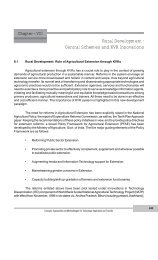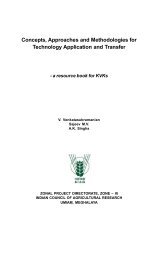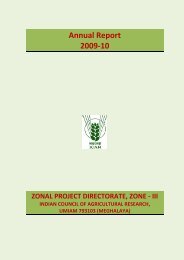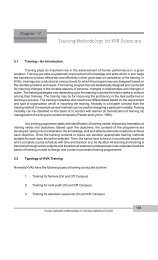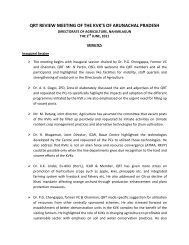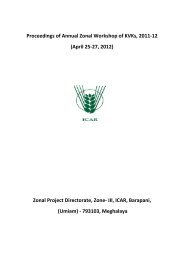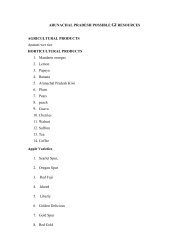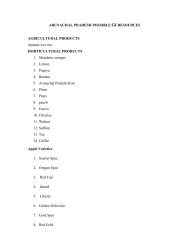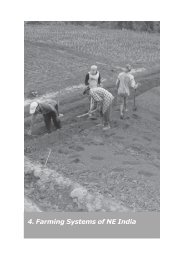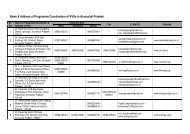Farming Systems Approach - ICAR, Zonal Project Directorate (Zone-III)
Farming Systems Approach - ICAR, Zonal Project Directorate (Zone-III)
Farming Systems Approach - ICAR, Zonal Project Directorate (Zone-III)
Create successful ePaper yourself
Turn your PDF publications into a flip-book with our unique Google optimized e-Paper software.
Sajeev M.V, V. Venkatasubramanian & A.K. Singhaa. Farmer – Back – To – Farmer Models (Rhodes and Booth, 1982)The basic philosophy upon which the model is based is that successful agricultural research anddevelopment must begin and end with farmer. Applied agricultural research cannot begin in isolationon an experimental station or with a planning committee out of touch with farm conditions. This meansobtaining information about, and achieving an understanding of the farmer’s perception of the problemsand finally to accept the farmer’s evaluation of the solution. Thus, research must strive to close thecircle, from proper identification of the problem to farmer’s acceptance or rejection.The purpose of diagnosis is to arrive at the widest possible consensus between farmers,social scientists and technologists on the definition of the problem to be solved. At this stage, it islikely, and even desired that the disagreements will arise between the social and the biologicalscientist over the interpretation of problems – ‘constructive conflict’. It is important the team membershave a mutual respect, confidence and working knowledge of each other’s discipline. With theproblem in mind, the team can now proceed forcefully with on-station research guided by morefarm level information in order to arrive at a potential solution. Armed with a potential solution, theteam now proceeds to a testing and adoption activity with the objective to fit the technology to thelocal circumstances with the farmer acting as the adviser. In most circumstances, the testing andadoption will first occur in the experiment station followed by on-farm trials. The information onthe technology’s acceptance or rejection by the farmer who is the final judge to decide on theappropriateness of a proposed technology need to be collected. If the technology is rejected, theentire process can be repeated to determine the reasons and find ways to overcome them. Thefinal stage involves the actual evaluation and use of the technology by the farmer under his conditions,resources and management.b. Farmer-First And Last Model (Chambers and Ghildyal, 1984)It is almost similar to the previous model. It starts with holistic and interdisciplinary appraisal offarm families, resources, needs and problems, and continues with on-farm and with-farmer R&Dwhile the scientists, experiment stations and laboratories act in a consultancy and referred role. Itfits the needs and opportunities of resource poor farmers better than transfer of technology models.It promises a greater contribution from agricultural research to the eradication of rural poverty inour country.Importance of FSR in North East India:The economic and social benefits from agricultural research can be extremely high. Thedramatic advances in productivity achieved in the green revolution in irrigated North West India inthe late 1960s is perhaps the internationally best-known example. The green revolution strategywas evolved in an era when the problem of poverty and hunger was largely seen as problem ofproduction, for growing more food. It concentrated mainly on those farmers and those areas withthe greatest apparent potential for producing more food. If it favoured the better-endowed areas,this was justified since they presented the conditions in which the new high-yielding technologiesgenerated on research stations could most readily be adopted. (Chambers and Ghildyal, 1984). Of26<strong>Farming</strong> <strong>Systems</strong> of North East India



